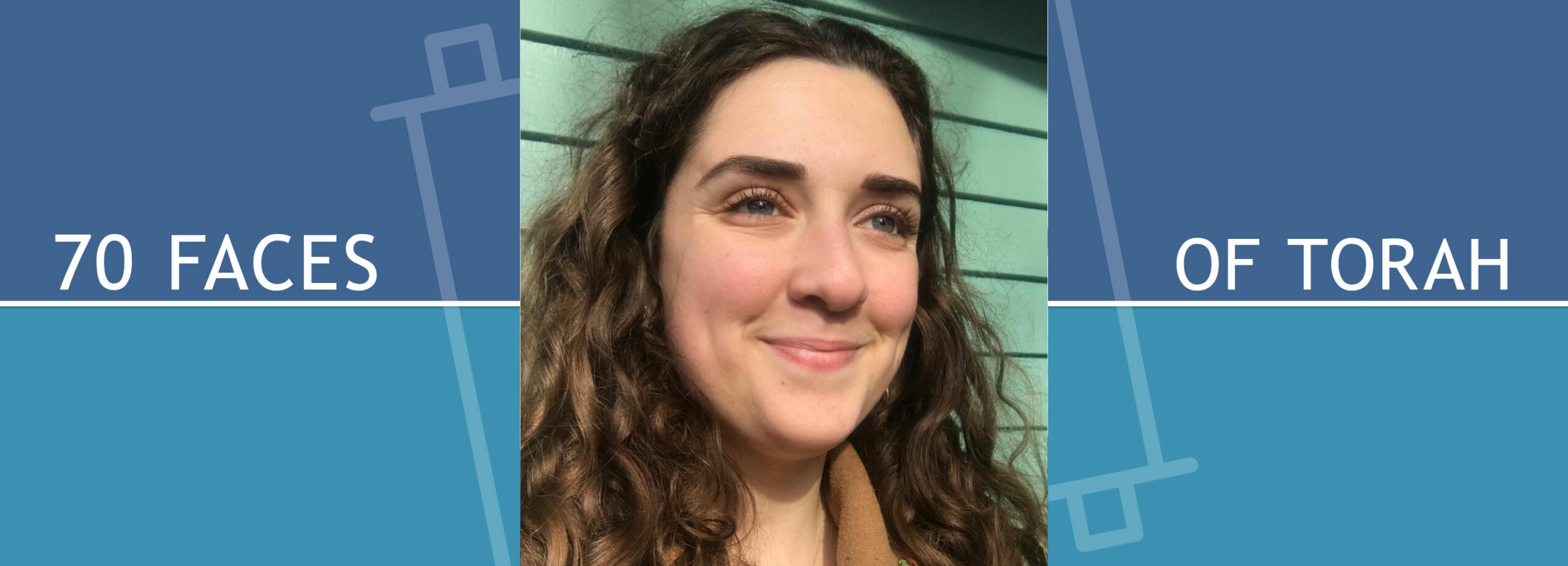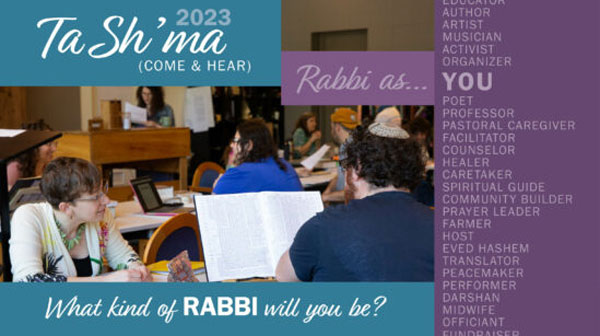Jewish learning Abodes of Possibility: Sukkot 5784

Exodus 33:12-34:26
I have always felt that celebrating Sukkot in New England means facing the tension between our physical vulnerability, and our tradition’s description of this season as “the time of our joy.” Some years it has been impossible to sing in the Sukkah while drenched and shivering, or to enjoy dinner as shreds of multicolored decorations are whipped into my food by the wind. But Sukkot, at its best, can serve as a time for grappling with the varied paradoxes of the world. One expression of the sacred paradox of Sukkot that I find particularly notable comes to us on Shabbat Chol HaMoed, the Shabbat between the official ‘holiday’ days of Sukkot. In that Shabbat’s Torah reading, we are thrust back to the moments following the Golden Calf, when in a moment of spiritual crisis and beseeching, Moshe goes up Mount Sinai to speak with G?d and asks to see the Divine. G?d responds that Moshe cannot see G?d and live. As a compromise, Moshe is instructed to take shelter in the cleft of a rock, protected by G?d’s hand. It is in this place that Moshe dwells, before the Divine passes before him in a cloud, and we hear the refrain of the words that so animate this Jewish month of Tishrei:
וַיֵּרֶד יְהֹוָה בֶּֽעָנָן וַיִּתְיַצֵּב עִמּוֹ שָׁם וַיִּקְרָא בְשֵׁם ה’’׃
וַיַּעֲבֹר יְהֹוָה ׀ עַל־פָּנָיו וַיִּקְרָא ה’’ ה’’ אֵל רַחוּם וְחַנּוּן אֶרֶךְ אַפַּיִם וְרַב־חֶסֶד וֶאֱמֶת׃
נֹצֵר חֶסֶד לָאֲלָפִים נֹשֵׂא עָוֺן וָפֶשַׁע וְחַטָּאָה וְנַקֵּה
“And YHVH descended in a cloud, and stationed G?d’s self beside him there, and called out the name YHVH. And YHVH passed before his face and called out, “YHVH YHVH, G?d showing-mercy, showing-favor, long-suffering in anger, abundant in loyalty and truth, keeping loyalty to the thousandth [generation], a bearer of guilt, rebellious sin, misdeed, and clearing [these sins].” — Exodus 34:5-7, partial
These words are eternally evocative but this year, as I moved to Jerusalem for my Hebrew College year in Israel, I found myself particularly drawn to the images of the place where G?d utters these words (within a cloud) and the place where Moshe hears them (within the cleft of a rock). My deepest reference and relationship to clouds is the fog that surrounds my home city of San Francisco. The clouds there are often misty and ephemeral, yet can be so powerfully dense that they completely block visibility, inconveniencing millions of people. And this attention to clouds extends beyond the particular fog of San Francisco. When we notice a sky without clouds, we often speak about it in reference to the clouds it lacks, saying “the sky is spotless.” Any way we speak of them, clouds have a sense of presence. Or in the case of the Cloud of G?d, The Presence.
In contrast, Moshe is cradled inside of the cleft of a rock, a formation which often appears as though the rock is splitting, or is a narrow opening that might trap us inside. It is often dark, without the guarantee of light ahead. And it is precisely in this harsh and mysterious fissure that Moshe experiences one of the most intimate moments with the Divine that we have in our tradition.
The softness and the harshness, the intimacy and the grandeur, of these two images strike me so startlingly that I can’t help feeling like that is the whole point. As Carl Jung explained, and Rabbi Sharon Cohen Anisfeld has championed, “the paradox is one of our most valued spiritual possessions and a great witness to the truth.” Jung wrote that “only the paradox comes anywhere near to comprehending the fullness of life.” We have a paradoxical and true G?d, so it is only fitting that we have an illustration of communing with that G?d blooming with paradox.
Our Sages and poetic liturgists notice the Cloud of G?d, HeAnan, in Moshe’s moment of revelation and connect it to the Clouds of Glory, the Ananei Kavod, which are ambiguous—yet definitively “protective”—clouds that are with the Israelites during their desert travels; eventually the Sages even connect these Clouds of Glory to the Sukkah itself. According to the Shulkhan Arukh, a 16th century Sephardic code of Jewish Law, the Ananei Kavod are a manifestation of G?d’s presence, which accompany and protect the Israelites from the desert’s searing sun. The Medieval French commentator Rashi bolsters this, saying that the Ananei Kavod led us throughout all of our forty years in the wilderness. Rabbi Yaakov ben Asher (a Medieval Rabbinic authority) goes further, saying that the clouds gave personal attention to every Israelite based on their own individual needs. And each of these Rabbinic authorities seem to notice that just like Moshe can, paradoxically, only commune with G?d when G?d is concealed in HeAnan, so too was the Divine able to reveal care to us through the Ananei Kavod because of their inherently concealing form. Centuries later, in the 1700s, Rav Moshe Adahan, head of the Moroccan Beit Din (Court of Law), connected the Ananei Kavod to the Sukkah itself. In his liturgical poem Sukkah v’Lulav, he wrote: “The Clouds of Glory encircled us as four directions, above and below.” Thus, the entire Sukkah is a manifestation of the Ananei Kavod.
It is hard to feel like the world we are in is soft, even when we are surrounded by people we love. It is hard to feel as though we are in a place of shade when the darkness threatens to be an unyielding night. It is hard for us to suspend our disbelief that the walls surrounding us are safe and reliable enough to risk joy. Yet, the text we read on Shabbat Chol Hamoed Sukkot urges us not to dispose of these feelings and these recognitions of hardness, but to understand that even when the Sukkah as the Ananei Kavod feels unreachable, sometimes the Sukkah as a crag in the rock can be exactly the cradle that we need. For Moshe, for G?d, for us, they are both abodes of possibility. May we continue to merit and find abodes of possibility, and be blessed to have the eyes to see them, and the faith to know that there will always be space for us in the crag, the cloud, and the paradox.
Please email the author to provide feedback.
Risa Dunbar is originally from the San Francisco, Bay Area. At eleven years old, she initiated her formal Jewish education, studying to be the first person in her family to become a Bat Mitzvah and enroll in Jewish day school. In 2017 she graduated from Brandeis University with a major in Anthropology and minors in Near Eastern and Judaic Studies, and Creative Writing. She then worked at the New Israel Fund, where she supported the LA, Boston, and Chicago regions in their work to fund progressive causes in Israel. In the summer of 2021, she served as the Head of Education for Camp Ramah in Northern California, working to construct meaningful tefillot, shabbatot, and other rituals and learning for all ages. In the summer of 2022 she interned for Lehrhaus, an innovative hybrid beit midrash/tavern and communal learning space in Somerville, MA, curating and acquiring books for their Beit Midrash and library, and building chevruta learning scaffolding. She has also served as a Jewish educator at the International Kallah program for BBYO, educating about self, communal, environmental, and spiritual care. In 2022-2023 she was the Rabbinic Intern at Ohav Shalom in Albany, NY, where she served as an adult, family, and children’s educator, wrote and delivered divrei torah, led communal prayer, and served as a pastoral presence for the community. She will spend the 2023-2024 Academic year living in Jerusalem before she returns to Somerville, MA.
Learn more about Hebrew College’s rabbinical and cantorial programs at Ta Sh’ma (Come & Hear), our November Open Houses (in-person & virtual options).


